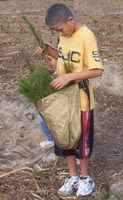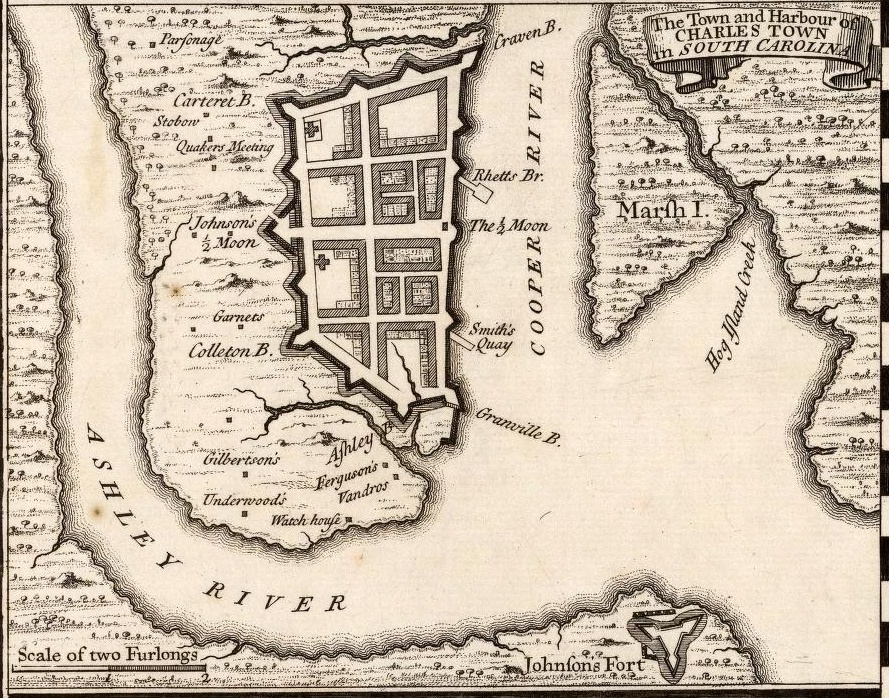|
Siege Of Pensacola (1707)
The siege of Pensacola included two separate attempts in 1707 by English-supported Creek Indians to capture the town and fortress of Pensacola, one of two major settlements (the other was St. Augustine) in Spanish Florida. The attacks, part of Queen Anne's War (the North American theater of the War of the Spanish Succession), resulted in the burning of the town, and caused most of its Indian population to flee, although the fort withstood repeated attacks. The battles were primarily fought in the nighttime hours due to the excessive heat of the day. The first siege, in August, resulted in the destruction of the town, but Fort San Carlos de Austria successfully resisted the onslaught. In late November, a second expedition arrived, and made unsuccessful attacks on three consecutive nights before withdrawing. Pensacola's governor, Don Sebastián de Moscoso, whose garrison was depleted by disease, recruited convicted criminals to assist in the fort's defense. Background E ... [...More Info...] [...Related Items...] OR: [Wikipedia] [Google] [Baidu] |
Battle Of Pensacola (other)
Battle of Pensacola may refer to: *Siege of Pensacola (1707), two separate siege attempts during Queen Anne's War by English-led Indians against a Spanish garrison *Capture of Pensacola (1719), the capture of Spanish Pensacola by French forces during the War of the Quadruple Alliance *Siege of Pensacola, a 1781 siege by Spanish forces against a British garrison during the American War of Independence *Battle of Pensacola (1814), an American attack on a British-Spanish force during the War of 1812 *Battle of Pensacola (1861), a Union attack on Confederate forts in Pensacola Bay during American Civil War {{Disambig ... [...More Info...] [...Related Items...] OR: [Wikipedia] [Google] [Baidu] |
Joseph Blake (governor)
Joseph Blake (died 1700), the nephew of English General at Sea Robert Blake, served as the governor of Carolina in 1694 and from 1696 to his death in 1700. Biography Joseph Blake was born in 1663,Carolana: Joseph Blake. President of the Council and Actring Governor of Carolina Province 1694 Retrieved 14 September 2015.Preservation Society of Charleston:Joseph Blake . in . He was the son of Benjamin Blake ... [...More Info...] [...Related Items...] OR: [Wikipedia] [Google] [Baidu] |
Jean-Baptiste Le Moyne, Sieur De Bienville
Jean-Baptiste Le Moyne de Bienville (; ; February 23, 1680 – March 7, 1767), also known as Sieur de Bienville, was a French-Canadian colonial administrator in New France. Born in Montreal, he was an early governor of Louisiana (New France), French Louisiana, appointed four separate times during 1701–1743. He was the younger brother of explorer Pierre Le Moyne d'Iberville. Early life Jean-Baptiste Le Moyne was the son of Charles le Moyne de Longueuil et de Châteauguay, Charles le Moyne, born in Longueil, Seine-Maritime, Longueil, near Dieppe, France, Dieppe, and Catherine Primot (also known as Catherine Thierry), born in Rouen, both cities in the Province of Normandy. Charles le Moyne established his family in the settlement of Fort Ville-Marie, Ville-Marie (present day Montreal) at an early age and had fourteen children. Exploration in the New World At the age of seventeen, Bienville joined his brother Iberville on an expedition to establish the colony of Louisiana. In ... [...More Info...] [...Related Items...] OR: [Wikipedia] [Google] [Baidu] |
Huguenot
The Huguenots ( , ; ) are a Religious denomination, religious group of French people, French Protestants who held to the Reformed (Calvinist) tradition of Protestantism. The term, which may be derived from the name of a Swiss political leader, the Genevan burgomaster Besançon Hugues, was in common use by the mid-16th century. ''Huguenot'' was frequently used in reference to those of the Reformed Church of France from the time of the Protestant Reformation. By contrast, the Protestant populations of eastern France, in Alsace, Moselle (department), Moselle, and Montbéliard, were mainly Lutheranism, Lutherans. In his ''Encyclopedia of Protestantism'', Hans Hillerbrand wrote that on the eve of the St. Bartholomew's Day massacre in 1572, the Huguenot community made up as much as 10% of the French population. By 1600, it had declined to 7–8%, and was reduced further late in the century after the return of persecution under Louis XIV, who instituted the ''dragonnades'' to forcibly ... [...More Info...] [...Related Items...] OR: [Wikipedia] [Google] [Baidu] |
Alabama People
The Alabama or Alibamu () are a Southeastern culture people of Native Americans, originally from Alabama. They were members of the Muscogee Creek Confederacy, a loose trade and military organization of autonomous towns; their home lands were on the upper Alabama River. The Alabama and closely allied Coushatta people migrated from Alabama and Mississippi to the area of Texas in the late 18th century and early 19th century, under pressure from American settlers to the east. They essentially merged and shared reservation land. Although the tribe was terminated in the 1950s, it achieved federal recognition in 1987 as the Alabama-Coushatta Tribe of Texas. Its 1,137 members have about of reservation. The Alabama-Quassarte Tribal Town is a federally recognized tribe, headquartered in Wetumka, Oklahoma. Language The Alabama language is part of the Muskogean language family. Alabama is closely related to Koasati and distantly to Hitchiti, Chickasaw and Choctaw. Also known as A ... [...More Info...] [...Related Items...] OR: [Wikipedia] [Google] [Baidu] |
Tallapoosas
The Tallapoosas were a division of the Upper Creeks in the Muscogee Confederacy. Prior to Indian Removal, Removal to Indian Territory, Tallapoosa lived along the Tallapoosa River in Alabama. They are also called the Cadapouches or Canapouches, which was mistakenly considered a synonym for the Catawba people, Catawba of the Carolina. 16th century Spanish explorers described towns along the Tallapoosa as being surrounded by protective wooden palisades. In later years, the palisades were no longer built. They made ceramics using grit as a temper. 17th century Over 30 towns along the Tallapoosa, Coosa River, Coosa, and Chattahoochee Rivers allied to form the Muscogee Confederacy. The Tallapoosa were among these Upper Creeks, who were more culturally and politically conservative than the Lower Creek towns. 18th century The Tallapoosas fought in the siege of Pensacola (1707), siege of Pensacola. Although these warriors proved their effectiveness in combining native tactics and Europea ... [...More Info...] [...Related Items...] OR: [Wikipedia] [Google] [Baidu] |
Stockade
A stockade is an enclosure of palisades and tall walls, made of logs placed side by side vertically, with the tops sharpened as a defensive wall. Etymology ''Stockade'' is derived from the French word ''estocade''. The French word was derived from the Spanish word ''estacada''. As a security fence The troops or settlers would build a stockade by clearing a space of woodland and using the trees whole or chopped in half, with one end sharpened on each. They would dig a narrow trench around the area, and stand the sharpened logs side-by-side inside it, encircling the perimeter. Sometimes they would add additional defence by placing sharpened sticks in a shallow secondary trench outside the stockade. In colder climates sometimes the stockade received a coating of clay or mud that would make the crude wall wind-proof. Builders could also place stones or thick mud layers at the foot of the stockade, improving the resistance of the wall. From that the defenders could, if they had the ... [...More Info...] [...Related Items...] OR: [Wikipedia] [Google] [Baidu] |
Charles Town Expedition
Lefebvre's Charles Town expedition (September 1706) was a combined French and Spanish attempt under Captain Jacques Lefebvre to capture the capital of the English Province of Carolina, Charles Town, during Queen Anne's War (as the North American theater of the War of the Spanish Succession is sometimes known). Organized and funded primarily by the French and launched from Havana, Cuba, the expedition reached Charles Town in early September 1706 after stopping at St. Augustine to pick up reinforcements. After a brief encounter with a privateer the ''Brillant'', one of the expedition's six ships, became separated from the rest of the fleet. Troops landed near Charles Town were quickly driven off by militia called out by Governor Nathaniel Johnson when word of the fleet's approach reached the area, and an improvised flotilla commanded by Colonel William Rhett successfully captured the ''Brillant'', which arrived after the other five ships had already sailed away in defeat. ... [...More Info...] [...Related Items...] OR: [Wikipedia] [Google] [Baidu] |
Apalachee Massacre
The Apalachee massacre was a series of raids by English colonists from the Province of Carolina and their Muscogee allies against a largely peaceful Apalachee population in northern Spanish Florida which took place in January 1704 during Queen Anne's War. Against limited Spanish and Apalachee resistance, a network of Catholic missions was destroyed by the raiders; most of their population were either killed, captured, fled to larger Spanish and French outposts, or voluntarily joined the English. The only major event of former governor of Carolina James Moore Sr.'s expedition was the Battle of Ayubale, which marked the only large-scale resistance to the raids by the Spanish and Apalachee. Significant numbers of the Apalachee, unhappy with the conditions they lived in under in the Spanish missions, simply abandoned their towns and joined Moore's expedition. They were resettled near the Savannah and Ocmulgee Rivers, where living conditions proved to be only slightly better. ... [...More Info...] [...Related Items...] OR: [Wikipedia] [Google] [Baidu] |
Siege Of St
A siege () . is a military blockade of a city, or fortress, with the intent of conquering by attrition, or by well-prepared assault. Siege warfare (also called siegecrafts or poliorcetics) is a form of constant, low-intensity conflict characterized by one party holding a strong, static, defensive position. Consequently, an opportunity for negotiation between combatants is common, as proximity and fluctuating advantage can encourage diplomacy. A siege occurs when an attacker encounters a city or fortress that cannot be easily taken by a quick assault, and which refuses to surrender (military), surrender. Sieges involve surrounding the target to block provision of supplies and reinforcement or escape of troops (a tactic known as "investment (military), investment"). This is typically coupled with attempts to reduce the fortifications by means of siege engines, artillery bombardment, mining (military), mining (also known as sapping), or the use of deception or treachery to bypass ... [...More Info...] [...Related Items...] OR: [Wikipedia] [Google] [Baidu] |
Battle Of Flint River
The Battle of Flint River, also called the Spanish-Indian Battle (1702) or the Battle of the Blankets , was a failed attack by Spanish and Apalachee Indian forces against Creek Indians in October 1702 in what is now the state of Georgia. The battle was a major element in ongoing frontier hostilities between English colonists from the Province of Carolina and Spanish Florida, and it was a prelude to more organized military actions of Queen Anne's War. The Creeks, assisted by a small number of English colonists led by trader Anthony Dodsworth, ambushed the invaders on the banks of the Flint River. More than half of the Spanish-Indian force was killed or captured. English and Spanish colonial authorities reacted to the battle by accelerating preparations that culminated in the siege of St. Augustine in November 1702. Background English and Spanish colonization efforts in South-eastern North America began coming into conflict as early as the middle of the 17th century. The fo ... [...More Info...] [...Related Items...] OR: [Wikipedia] [Google] [Baidu] |






